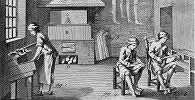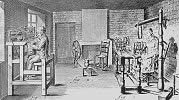 The
Stockings Knitters, 1698. By Christoph Weigel. The different
stages necessary in knitting the stockings are shown here. Note
that it is knitted by hand. This is not because there was no
knitting machine yet invented, on the contrary. The first knitting
machine, which was not efficient by then, was invented in England
in Queen Elizabeth I's reign. But hand knitting continued on
for a long time and was a flourishing craft. Machine knitted
silk stockings exclusively for the aristocracy and those who
could afford them. German The
Stockings Knitters, 1698. By Christoph Weigel. The different
stages necessary in knitting the stockings are shown here. Note
that it is knitted by hand. This is not because there was no
knitting machine yet invented, on the contrary. The first knitting
machine, which was not efficient by then, was invented in England
in Queen Elizabeth I's reign. But hand knitting continued on
for a long time and was a flourishing craft. Machine knitted
silk stockings exclusively for the aristocracy and those who
could afford them. German |

Stockings
Knitters, 1751. From Diderot's Encyclopédie.
Models for stockings can be seen in the back, neatly stacked
up. Knitting the fine stockings had by then been a machine process
for quite some time. French |
 Embroideress
with Amor, 1627. By J. Sweelinck. A lady is shown embroidering
on a frame, which keeps the material tight. A pair of shears
are lying on the floor, but scissors were also in use, as can
be seen on an earlier engraving from 1568, where a silk-embroiderer
is shown with his equipment. Dutch Embroideress
with Amor, 1627. By J. Sweelinck. A lady is shown embroidering
on a frame, which keeps the material tight. A pair of shears
are lying on the floor, but scissors were also in use, as can
be seen on an earlier engraving from 1568, where a silk-embroiderer
is shown with his equipment. Dutch |

Stockings
Knitters, 1751. From Diderot's Encyclopédie.
Here the machine can be seen on the left, where a stocking is
currently being knitted. The woman on the right is gathering
the fine silk threads used on the devices on her table. Note
that here in this trade in the middle of the 18th century men
and women are working together. French |
 French
Embroiderer's Workshop (detail left), 1750. From Diderot's Encyclopédie. The embroideress, note that now
two female workers are shown, embroidering was in earlier times
a male profession, showing a side panel of a waistcoat. Garments
were always first embroidered and then cut out. French French
Embroiderer's Workshop (detail left), 1750. From Diderot's Encyclopédie. The embroideress, note that now
two female workers are shown, embroidering was in earlier times
a male profession, showing a side panel of a waistcoat. Garments
were always first embroidered and then cut out. French |
 French
Embroiderer's Workshop (detail left), 1750. From Diderot's Encyclopédie. The embroideress is obviously working
on the other waistcoat panel. Scissors, thread and bowls with
probably purls and sequins lying on the stretched out fabric,
kept taught by the large frame. French French
Embroiderer's Workshop (detail left), 1750. From Diderot's Encyclopédie. The embroideress is obviously working
on the other waistcoat panel. Scissors, thread and bowls with
probably purls and sequins lying on the stretched out fabric,
kept taught by the large frame. French |
 The
Silk Embroiderer, 1698. By Christoph Weigel. By then professional
embroidery, just like all the other crafts, were done by men.
Women to embroider at home for their own use. Panels of finished
embroideries are leaning against the wall, while the man is
working, bent over the frame, which is simpler than the one
compared to in 1750, but the logic behind the embroidery frame
workings has been the same for centuries already. Skeins of
coloured silks are gathered in a basket behind the embroidery. German The
Silk Embroiderer, 1698. By Christoph Weigel. By then professional
embroidery, just like all the other crafts, were done by men.
Women to embroider at home for their own use. Panels of finished
embroideries are leaning against the wall, while the man is
working, bent over the frame, which is simpler than the one
compared to in 1750, but the logic behind the embroidery frame
workings has been the same for centuries already. Skeins of
coloured silks are gathered in a basket behind the embroidery. German |
 Embroidery
Lessons, 1689. By e. Porzelius. Girls are seen who receive
their embroidery lessons, the first steps to a skill which was
highly regarded everywhere. Some home-made needlework is surviving
in museums today and the quality is truly astounding, showing
great skills and artwork. Note the girl with the bobbin lacemaking
pillow on the right. German Embroidery
Lessons, 1689. By e. Porzelius. Girls are seen who receive
their embroidery lessons, the first steps to a skill which was
highly regarded everywhere. Some home-made needlework is surviving
in museums today and the quality is truly astounding, showing
great skills and artwork. Note the girl with the bobbin lacemaking
pillow on the right. German |
 The
Weaver, 1698. By Christoph Weigel. The loom can be seen
in detail on this engraving, worked with pedals. The worker
is about to move the shuttle back through the threads. The man
on the left is pulling wool through a weaving comb. A barrel
and basket with wools are seen on the foreground. German The
Weaver, 1698. By Christoph Weigel. The loom can be seen
in detail on this engraving, worked with pedals. The worker
is about to move the shuttle back through the threads. The man
on the left is pulling wool through a weaving comb. A barrel
and basket with wools are seen on the foreground. German |
|









